The Secret to Studio Ghibli’s Grey Antagonists
To most people, antagonists are nothing but evil.
In fact, it’s become so common to think of antagonists this way that the word has become almost synonymous with traditional villains: Sauron, Scar, Loki, Sheer Khan, Mother Gothel, Emperor Palpatine, the Joker, Darth Vader, or Ursula.
However, there’s another view of antagonists that sees storytelling a bit differently—and with a lot more nuance.
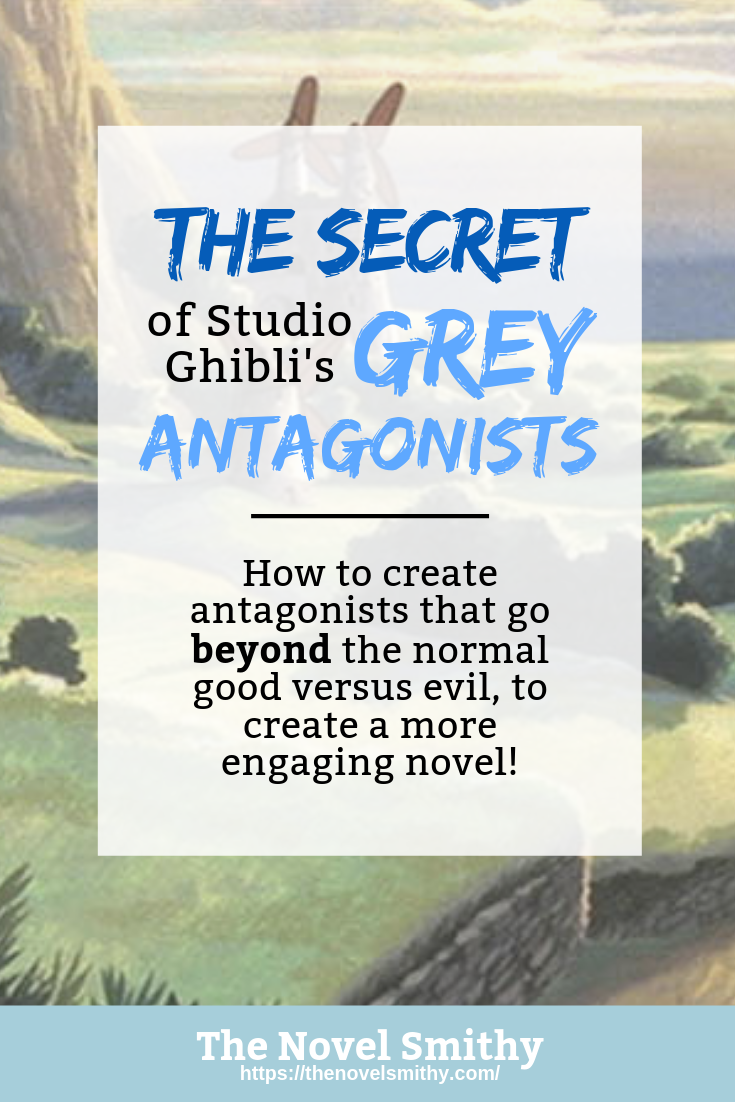
Instead of assuming your antagonist represents the dark side or a polar opposite against your more noble protagonist, what about creating a story where there are no easy answers?
In these stories the final battle is waged between conflicting ideas, not between good and evil. That’s what makes them so impactful—they explore the way two characters pursue different ends, each with equally “good” reasons for doing so.
Neither character is wrong, or the villain!
While the good versus evil dichotomy so common in Western media has its own value (there’s nothing wrong with a story featuring a traditional hero and villain of course!), it’s important to know there’s another option out there.
After all, the real world rarely functions in black and white, but in shades of grey. When you think of it that way, Studio Ghibli’s grey antagonists begin making a lot more sense.
What Is a Grey Antagonist?
Contents
The Basics of a Grey Antagonist:
At their most basic, a grey antagonist is a character who is only the antagonist because of the perspective of the protagonist.
Their goals aren’t innately evil or wrong. Instead, their actions conflict with the goals and beliefs of the protagonist. If you turned the story around and focused on them as the hero instead, they often would fulfill that role just as well as they fulfill the antagonizing role.
This differs from characters that are evil, but still relatable.
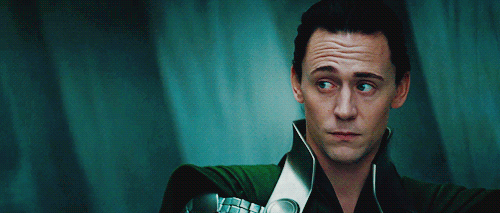
Consider Loki from the MCU, specifically from the first Thor movie: we can sympathize with him, because we understand why he’s lashing out. He was neglected, lied to, and abused by his family and others. Now he’s expressing that hurt and anger through violence.
However, this sympathetic nature doesn’t make Loki a grey antagonist—far from it. Even though we understand his character motivations, Loki is still objectively evil. He murders people in cold blood, causes massive destruction and suffering, and does so out of nowhere, during relative peacetime. There are no real justifications for his actions, meaning he’s a traditional villain in every sense of the word.
Grey antagonists buck this trend, presenting a world where there are many, equally valid perspectives.
A Different View of Right and Wrong:
What makes grey antagonists so interesting is that they aren’t that common in Western storytelling.
Traditional European stories lean heavily on the Three Act Structure and on clean-cut, good versus evil tales. In these, the hero (protagonist) is doing battle with a villain (antagonist) who is usually bent on mass destruction, either of society or of individuals important to the hero.
On the other hand, traditional Asian storytelling often has a different perspective.
This is where grey antagonists have their largest foothold. In these stories, the focus is more on creating balance than on good dominating evil. Much like the basic idea of the Ying and Yang, everything and everyone contains some element of both light and darkness. In these stories, the antagonist is often a good person who simply made misguided or cruel choices. The story isn’t about destroying them, but is instead about redeeming them by guiding them to the correct path.
While it might strike you as weird, there are entire series in Japan focused on villains dedicated to ending all war… And yes, they are the villains!
The “Villains” of Studio Ghibli
Nowhere is this difference in perspective clearer than in the work of Hayao Miyazaki.

I’ve talked a lot about Miyazaki in the Complete Story Structure Series, but for a quick introduction, he’s the co-founder and one of the main creative voices behind Japan’s Studio Ghibli. This animation studio has spent the last few decades creating some of the most beautiful and impactful movies around, in large part thanks to their more nuanced view of right and wrong.
Grey antagonists are rampant in Ghibli and Miyazaki’s movies. While there are more traditional Western villains in Ghibli’s work, such as Muska in Laputa: Castle in the Sky, these are much less common than grey antagonists.
Despite this, Ghibli’s antagonists still possess all the qualities of a good villain:
- They’re scary and intimidating
- They have their own personal motives beyond “stopping the hero”
- They have their own character arcs
- And they can be downright terrifying!
So the question then becomes: how has Studio Ghibli written antagonists that create genuine tension in their movies, while also not being evil? To answer that question, you’ll want to be familiar with Ghibli’s grey antagonists.
Ghibli’s Many Grey Antagonists
Princess Kushana – Nausicaä of the Valley of the Wind:
Nausicaä of the Valley of the Wind is one of those movies that leaves you pondering some of life’s deepest questions. This is in large part thanks to the conflict between Princess Kushana, the antagonist, and the movie’s protagonist, Princess Nausicaä.
Nausicaä is the leader of an isolated village in the aftermath of an apocalyptic war, while Kushana leads a much larger neighboring kingdom. The planet is slowly being consumed by the Toxic Jungle and resources are becoming more and more scarce. In fact, many nations have already been overgrown and their inhabitants killed. It’s both Nausicaä and Kushana’s mission to protect their people and survive in this damaged world.
The conflict between them starts because of their different methods.
Nausicaä believes humans have a responsibility to create harmony with nature. Humans created the Toxic Jungle after polluting and destroying the earth through war, so now they must return to a more balanced life.
Kushana, however, see’s things differently. She watches as the Jungle encroaches closer to her people and as other nations kill each other for resources and comes to the conclusion that dominance is the only way to achieve security. She builds a massive army and begins carrying out a plan to control a super weapon leftover from the past.
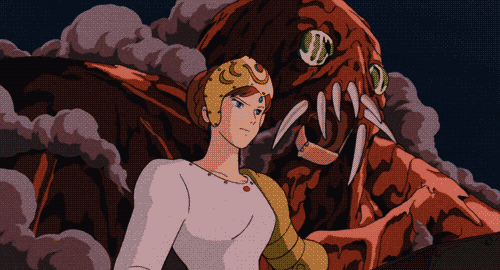
It’s easy to see why these two fight—but neither of them are evil.
Nausicaä is the easiest to sympathize with because she’s a traditional messiah figure, but Kushana is noble in her own way. Is she wrong for doing everything she can to stop the Jungle’s spread, even if we, the audience, know it’s misguided?
Ultimately, her nature as a grey antagonist is what gives this movie its depth, and makes it such a lasting sci-fi classic.
Lady Eboshi – Princess Mononoke:
Lady Eboshi from Princess Mononoke is much like Princess Kushana.
She’s the leader and founder of the Ironworks, a mining community and refuge for social outcasts, lepers, and the homeless, built in the center of a massive forest. In order to sustain themselves, the residents of the Ironworks are clear-cutting portions of the forest to build their homes and make way for further mining operations, which has angered the local forest guardians.
To make things more complicated, Eboshi is hunting the Deer God, the deity of this region. If she sends its head to the Emperor, he’ll grant the Ironworks protection from the aggressive nearby daimyo, Lord Asano.
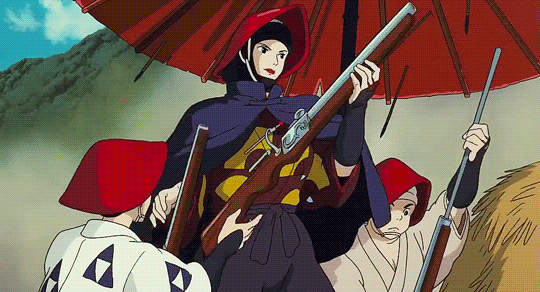
Just like Princess Kushana, Eboshi is doing everything she can to protect her people. Of course, what she’s doing has deadly consequences she doesn’t fully understand. Killing the Deer God also kills the forest and everything that lives inside it, including the people of the Ironworks.
The movie’s hero, Ashitaka, is allied with the forest spirits and is trying to stop Eboshi, but he also understands why she’s making the choices she is. We, the audience, also understand, and the result is an antagonist who we genuinely fear because of her single-minded focus, but who we also sympathize with on some level.
We know that in her position we’d be making the same decisions.
Just like the previous movie on this list, this contrast makes Princess Mononoke a much deeper, more engaging film. It’s not a simple fantasy romp, but a movie that makes you think about the decisions you’d make, and if they would be the right ones.
Curtis – Porco Rosso:
After the dark tone of the previous two movies, let’s look at something more playful.
Porco Rosso is a silly film about an ex-WWI fighting ace who now works as a bounty hunter against air pirates in the Mediterranean. He soundly thrashes these pirates almost every time he finds them, so they hire an American fighter pilot named Curtis to hunt Porco down and put an end to his bounty hunting days.
That right there makes Curtis look like a pretty typical villain, but when you look closer, you’ll see he has more in common with Princess Kushana than with Loki or Scar.
You see, no one in this movie is interested in killing anyone else.
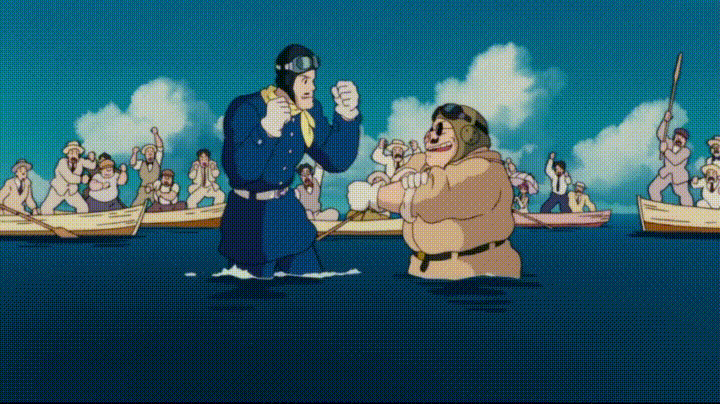
Instead, the goal is to embarrass the other side until they give up. At first, Curtis’ main mission is simply to gain local fame by defeating Porco, but this shifts when he meets Porco’s personal mechanic, a young girl named Fio. The main conflict then becomes a battle between Porco’s desire to protect Fio and Curtis’ hope to charm her into marrying him.
While you may disagree with the methods Curtis employs, he isn’t “evil.”
He never forces himself on Fio the way a traditional romance villain might and instead tries to win her hand through foolish contests of strength and showmanship. Porco is only sucked into the conflict because Curtis believes Porco is the one standing between him and Fio.
Overall, Curtis’ role as a grey antagonist adds something unique to this movie. While it isn’t the deep moral questions of the previous two, it is an added layer of silliness, creating a comedic film where the you have a clear antagonist to create tension, but not one that detracts from the overall lighthearted tone of the story.
Self-Doubt – Kiki’s Delivery Service:
Finally, considering this is my favorite movie of all time, it seemed wrong to discuss how Ghibli creates antagonists without mentioning the lack of an antagonist in Kiki’s Delivery Service.

It’s impressive how Miyazaki created a story with genuine tension, but no clear antagonist.
The story centers on the struggles of the movie’s protagonist, Kiki, as she fights against her own self-doubt and homesickness after moving to a seaside city to begin her training as a witch. This “antagonist” causes the conflict in the story and consistently runs counter to Kiki’s goals. When she wants to make friends or expand her blooming delivery business, she has to fight against herself, not another character.
This movie definitely isn’t for everyone, but it presents yet another option instead of the traditional good versus evil narrative: What if there was no antagonist at all, only the day-to-day struggles of a normal girl?
How to Use Grey Antagonists in Your Own Novel
Give Them Noble Motives, but Flawed Methods:
As you might have noticed, all the grey antagonists we explored today were striving towards a valid goal, be that protecting their community, earning necessary allies, or finding love.
However, their methods were flawed.
They may have had acceptable and even righteous goals, but the ways they tried to achieve them were shortsighted, naïve, overly aggressive, or lacking necessary information. While we could respect and even understand their goals, we could also cheer on the protagonist because we knew the antagonist’s methods would cause more harm than good.
If you’re looking to create a grey antagonist of your own, this should be your first starting place. What is their end goal, and what flawed way will they try to achieve it?
Don’t Make Them Wrong, Just Wrong for Your Protagonist:
Grey antagonists are all about showing alternative angles to the same ideas.
Your protagonist then, is a great jumping off point for forming your grey antagonist:
- What does your protagonist believe?
- What is their goal?
You’ll likely find that your grey antagonist conflicts with your protagonist because they view your protagonist’s goal from a different angle. They aren’t wrong, they’re just approaching the problem in a way your protagonist doesn’t agree with. They’re pursuing different methods to the same general idea because of slightly different perspectives.
So, when creating your own grey antagonist, pay special attention to your protagonist’s central beliefs and what alternative angles might be present for that same idea.
Create a Foil Character Based on Beliefs:
Another important aspect of the antagonists we explored today was their role as foil characters for their respective protagonists.
This is standard for most antagonists. Foil characters are simply characters that mirror aspects of the protagonist’s personality, goals, and flaws in more extreme ways. They usually act as a warning, showing the dangers of your protagonist’s flaws run amok. However, in Ghibli’s work, the grey antagonists are more there to contrast the protagonist’s beliefs.
Take Princess Kushana. She and Nausicaä have the same goal, but whereas Nausicaä believes she needs to protect her people at her own risk, Kushana wants to protect her people at anyone’s risk. She represents an extreme form of Nausicaä, striving to achieve her goal with more intense, aggressive methods.
Your own grey antagonist may make an excellent foil character in the same way, but instead of mirroring your protagonist’s flaw, try having them represent the most extreme form of their beliefs.
Understand the Grey Sides of Life:
Based on the ideas of the previous few points, I imagine you can see why it would be hard to create a grey antagonist without having a good grasp on the issues you’re exploring in your story.
You see, the world is rarely one way or the other. Instead, it’s almost always a spectrum of potential ideas, and understanding those ideas is critically important as a writer. To write about the issues facing the world in a realistic, respectful way (and in a way that does your characters justice) you need to think carefully about each angle from the many points of view out there.
Do this by putting yourself in your antagonist’s shoes.
From their perspective, what is right and wrong?
Instead of viewing everything from the lens of your protagonist, think about things as if you were the character in question. Not only is this beneficial no matter what character you’re writing, but it’s practically a requirement for creating compelling, successful grey antagonists.
Avoid Purely Sympathetic Characters:
Many grey antagonists will be sympathetic to your readers, however there’s a big difference between just a sympathetic character and a grey antagonist. Think back to Loki for a moment.
Like I mentioned earlier, Loki is sympathetic, but he isn’t a grey antagonist.
He’s just a traditional villain with an admittedly compelling, sad backstory. On the other hand, Princess Kushana, Curtis, or Lady Eboshi may all strike a chord with you, but their status as grey antagonists has more to do with their actions than with how well their motivations are established.
Creating strong motivations is important, but before you begin writing your grey antagonist, make sure you’re actually creating a character who is morally just despite conflicting with your protagonist, not just sympathetic.
The Role of a Grey Antagonist
As much as I may have praised grey antagonists in this article, I don’t want to discount how complex they can be to write, and write well.
Creating a grey antagonist and doing them justice will often require you to face difficult questions about right versus wrong and human morality. What’s most challenging about this is that you won’t be able to take a clear-cut stance on whatever issue you’re exploring. Much of it will be left up to your readers, and that can be scary for an author, especially if you’re writing about something you feel strongly about.
Yet, I’d argue that’s the best thing about grey antagonists.
By showing a world that isn’t plain black and white, you also open your story to a wider view of the life.
- Do the ends justify the means?
- Should we put restraints on ourselves as individuals to protect the group?
- What is our responsibility to other humans versus the planet?
- Is our tribe more important than others?
These aren’t easy questions, and are just some of the things touched on in the movies we discussed today, but they’re also what set these stories apart from others. Tackling major issues like these is difficult, but when handled with nuance, care, and patience, it can make your story a lasting presence in the minds of your readers for years or even decades to come! 🙂


Leave a Reply